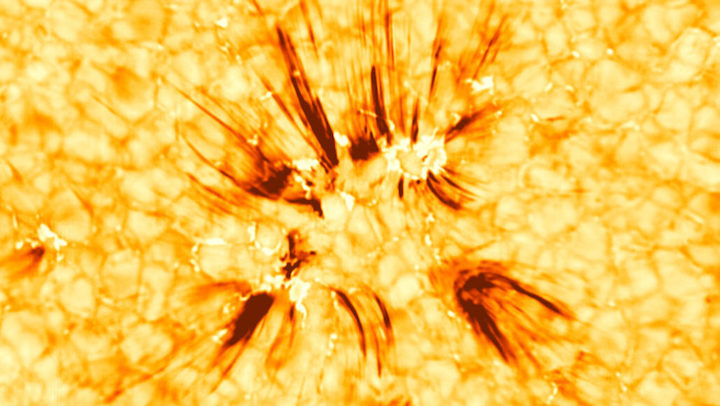17.11.2019

Whiskery plasma jets, known as spicules, on the sun appear as dark, threadlike structures in this image, acquired at the Goode Solar Telescope in Big Bear, Calif.
Tendrils of plasma near the surface of the sun emerge from realignments of magnetic fields and pump heat into the corona, the sun’s tenuous outer atmosphere, a study suggests.
The new observation, described in the Nov. 15 Science, could help crack the century-plus mystery of where these plasma whiskers, called spicules, come from and what role — if any — they play in heating the corona to millions of degrees Celsius.
Spicules undulate like a wind-whipped field of wheat in the chromosphere, the layer of hot gas atop the sun’s surface. These plasma filaments stretch for thousands of kilometers and last for just minutes, shuttling ionized gas into the corona. Astronomers have long debated how spicules form — with the sun’s turbulent magnetic field being a prime suspect — and whether they can help explain why the corona is a few hundred times as hot as the sun’s surface (SN: 8/20/17).
To look for connections between spicules and magnetic activity, solar physicist Tanmoy Samanta of Peking University in Beijing and colleagues pointed the Goode Solar Telescope, at Big Bear Solar Observatory in California, at the sun. They snapped images of spicules forming, while also measuring the surrounding magnetic field. The team discovered that thickets of spicules frequently emerged within minutes after pockets of the local magnetic field reversed course and pointed in the opposite direction from the prevailing field in the area.
Counterpointing magnetic fields create a tension that gets resolved when the fields break and realign, and the team postulates that the energy released in this “magnetic reconnection” creates the spicules. “The magnetic field energy is converted to kinetic and thermal energy,” says study coauthor Hui Tian, a solar physicist also at Peking University. “The kinetic energy is in the form of fast plasma motion — jets, or spicules.”
To see if this energy made it into the corona, the team pored through images acquired at the same time by NASA’s orbiting Solar Dynamics Observatory. Those data revealed a glow from charged iron atoms directly over the spicules. That glow, Tian says, means the plasma reached roughly 1 million degrees Celsius. Whether that’s enough to sustain the scorching temperature throughout the corona, however, remains to be seen.
“Their observations are amazing,” says Juan Martínez-Sykora, a solar physicist at the Lockheed Martin Solar & Astrophysics Laboratory in Palo Alto, Calif.
Capturing this level of detail is difficult, Martínez-Sykora says, because individual spicules are relatively small and come and go so quickly. He does caution, though, that the magnetic reconnection story needs to be checked with computer simulations or more observations. As it stands, it remains a postulation, he says.
Quelle: ScienceNews
